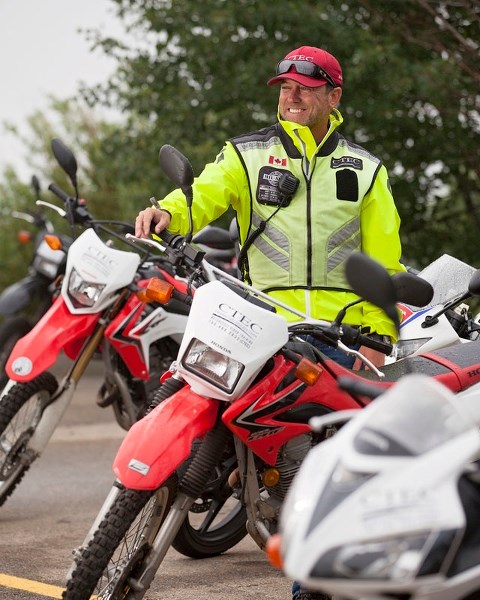Summer is meant for motorcycles, and bike lovers are out enjoying the short season and all that it comes with – the feel and freedom of the ride, the gear, the culture – it’s what brings thousands across Alberta to rider training programs to learn the skills and safety savvy needed to handle a motorcycle with confidence.
St. Albert residents have likely seen the ribbon of motorcycle riders and instructors who take over one end of the parking lot at Servus Place every April through October. CTEC (Canadian Traffic Education Centre), one of the province’s most popular training programs, runs two-day, road-focused courses here throughout the season. Rain or shine, every Tuesday to Sunday, riders make their way through St. Albert school and industrial zones, the downtown, and amidst pedestrian and car traffic to get practical training on how to safely ride a motorcycle.
CTEC creator James McCarthy, who ran the popular NAIT training program from 2003 to 2009, said he operates with a “student first” philosophy under the supervision of energetic – but patient – instructors.
“Safety isn’t a skill, it’s an attitude. Hopefully students come with the right attitude, and we can focus on the skills,” said McCarthy, who trains over 1,200 men and women from age 16 to 81 annually, some who want to unlearn bad habits, and others who’ve never touched a bike before.
“I did off-road bikes before, but just bought my first motorcycle. I want to learn how to ride the right way,” said business owner and student Robb Kipling.
McCarthy said about half his students already have a bike in the garage, maybe learning to ride from family or friends, but without the foundational skills needed to ride confidently. “Adults need to learn from experience, but with an understanding of the basic building blocks,” he said. Things like collision-avoidance strategies, motorcycle control, starting the engine, clutch operation, balance, shifting gears and braking are all addressed in the course.
And while other programs offer just the use of a motorcycle for training, CTEC goes above and beyond, providing free helmets, gloves and jackets too. When it comes time for testing, CTEC students get free use of a bike and gear, while a “free practice for life” policy allows former students to get extra practice in any day of operation between noon and 1 p.m. And, if a student feels overwhelmed and can’t complete the course, CTEC allows a free “do-over” of the entire program.
“We have a dedication to the student. We keep contact through Facebook, barbecue nights and by offering free spring tune-up and winter maintenance sessions,” McCarthy said. “People come from all over to take the course, and we have long wait lists too, so we do everything we can to benefit the students. My philosophy is, “we stick with you until you’re successful.”
St. Albert native and CTEC instructor Eric deJong said he helps dreams come true for people who’ve always wanted to ride – he has even taught his parents through the CTEC program. “There’s a freedom on a bike – no distraction of talk or radio – you can just be in the moment,” said deJong.
McCarthy said motorcycle riders face issues car drivers do, but to a much more serious degree – bad weather, potholes and inattentive drivers who are texting or talking – so it means a greater focus on driving safely and defensively, anticipating potential problems in traffic.
“We’re open and vulnerable on the road – our protection is up here,” McCarthy said, pointing to his head. “We’re not watching the movie – we’re in the movie.”
How to ride
– Various motorcycle training programs operate in the Edmonton area including the Alberta Safety Council, TNT Motorcycling, and CTEC. Costing roughly $500 for a couple of days of training, the programs vary in how they combine classroom and on-road training, and what equipment they provide. All provide the motorcycles for training.<br />– To get a Class 6 motorcycle licence, Albertans have to pass a written test and road test with a registry agent.<br />– To take a motorcycle training course, no licence is required (CTEC requires students to have a Class 7 learner’s permit), but riders must be at least 16 years old.
Where to ride
While many events take place in the Edmonton region, dedicated to motorcycle riders, the camaraderie among bike enthusiasts means there’s often a draw to join riders' groups. The Edmonton Motorcycle Riders Group promotes the “pleasure of camaraderie, adventures on the open road, and supporting of worthwhile causes in a safe group riding environment.”<br />If you’re simply interested in riding in a group on occasion, the newly formed Old Strathcona Riders Association may suit. The OSRA website said it welcomes any and all riders, with any make or model of motorcycle.




